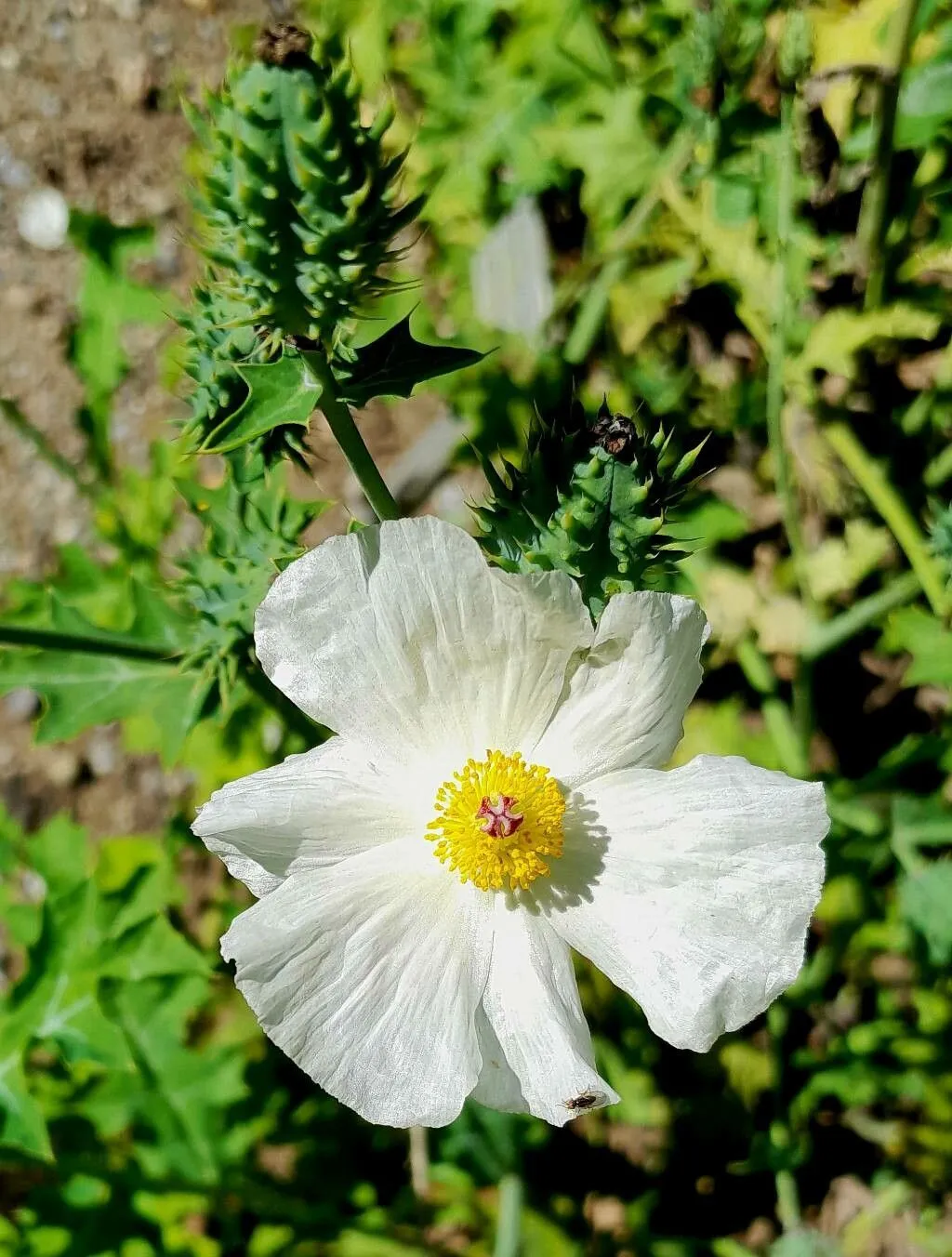
Author: G.B.Ownbey (Fedde)
Bibliography: Mem. Torrey Bot. Club 21:128. 1958
Year: 1958
Status: accepted
Rank: species
Genus: Argemone
Vegetable: False
Observations: WC. & C. U.S.A.
The Crested pricklypoppy, scientifically known as Argemone polyanthemos, is a captivating member of the Papaveraceae family, cherished for its distinctive and ornamental flowering features. This species, intricately described in the Mem. Torrey Bot. Club (1958) by G.B. Ownbey, is a staple within the diverse flora of the west-central and central regions of the United States.
The Crested pricklypoppy is easily recognizable by its striking, large white flowers which often exhibit crested forms. These blooms stand out dramatically against the plant’s spiky, green foliage, creating a stark yet beautiful contrast that is both ornamental and interesting from a botanical perspective. The spines and prickles on the plant are a typical defense mechanism against herbivores, a common trait found within its family.
This species thrives in a variety of environments, showcasing its versatility and adaptability. It can often be found in open fields, along roadsides, and in other disturbed areas, displaying a knack for resilience in tougher conditions where other plant species might struggle. The Crested pricklypoppy’s ability to prosper in such environments illustrates its robust nature.
The deep taproot of Argemone polyanthemos allows it to access water from deeper soil layers, making it relatively drought-tolerant. This functional adaptation not only aids in its survival during periods of limited precipitation but also means it plays a role in preventing soil erosion in its native habitats.
Being a member of the Papaveraceae family, this plant shares lineage with other poppies, contributing to the family’s reputation for producing substance-rich and pharmacologically significant plants. While the Crested pricklypoppy itself may not hold major pharmaceutical value, its familial connections endow it with an intrinsic botanical significance.
Observing Argemone polyanthemos in its natural habitat provides insight into the ecological dynamics of its native regions. It forms a part of the intricate web of flora that supports local wildlife, providing nectar for pollinators and serving as a minor food source for certain animals adept at navigating its prickly defenses.
Overall, the Crested pricklypoppy is a plant of notable interest, both for its striking appearance and its ecological tenacity. Whether appreciated in wild landscapes or studied for its botanical characteristics, Argemone polyanthemos remains a fascinating specimen within the diverse world of flowering plants.
Eng: annual pricklypoppy, bluestem prickly poppy, crested pricklypoppy, plains prickly-poppy, pricklypoppy, thistle poppy, white prickly poppy
Swe: vit taggvallmo
En: Crested pricklypoppy, Annual pricklypoppy, Bluestem prickly poppy, Plains prickly-poppy, Pricklypoppy, Thistle poppy, White prickly poppy
Ar: أرجمون كثير الأزهار
Fi: Valkopiikkiunikko
Sv: Vit taggvallmo
Taken Aug 23, 2022 by Anatas (cc-by-sa)
Taken Aug 23, 2022 by Anatas (cc-by-sa)
Taken Aug 23, 2022 by Anatas (cc-by-sa)
Taken Aug 23, 2022 by Anatas (cc-by-sa)
Taken Aug 23, 2022 by Anatas (cc-by-sa)
Taken Aug 23, 2022 by Anatas (cc-by-sa)
Taken Aug 23, 2022 by Anatas (cc-by-sa)
Growth form>: Single Stem
Growth habit>: Forb/herb
Growth rate>: Rapid
Ph maximum: 8.5
Ph minimum: 7.0
Family: Myrtaceae Author: (F.Muell.) K.D.Hill & L.A.S.Johnson Bibliography: Telopea 6: 402 (1995) Year: 1995 Status:…
Family: Rubiaceae Author: Pierre ex A.Froehner Bibliography: Notizbl. Bot. Gart. Berlin-Dahlem 1: 237 (1897) Year:…
Family: Sapindaceae Author: Koidz. Bibliography: J. Coll. Sci. Imp. Univ. Tokyo 32(1): 38 (1911) Year:…
Family: Asteraceae Author: A.Gray Bibliography: Pacif. Railr. Rep.: 107 (1857) Year: 1857 Status: accepted Rank:…
Family: Fabaceae Author: Medik. Bibliography: Vorles. Churpfälz. Phys.-Ökon. Ges. 2: 398 (1787) Year: 1787 Status:…
Family: Aspleniaceae Author: (Cav.) Alston Bibliography: Bull. Misc. Inform. Kew 1932: 309 (1932) Year: 1932…